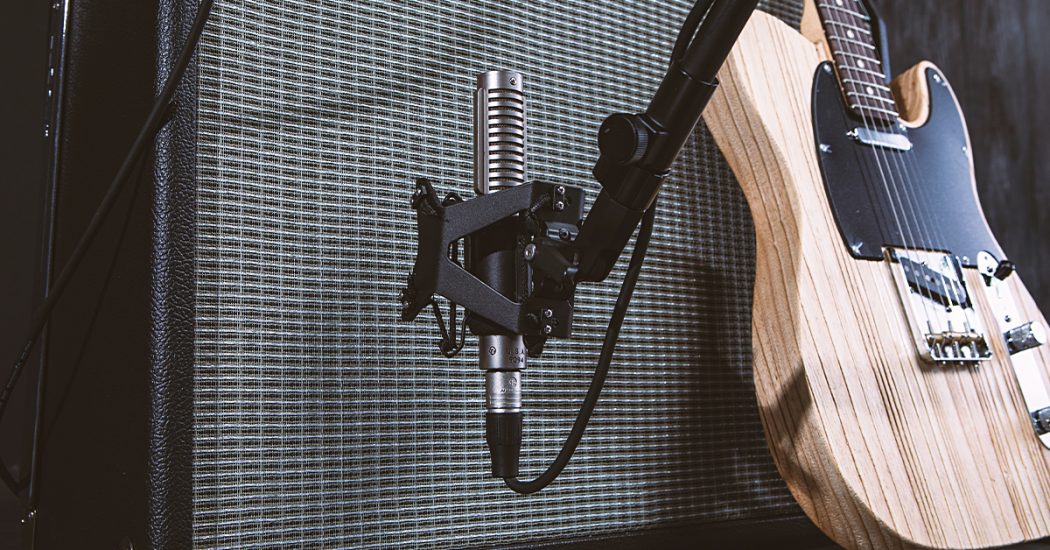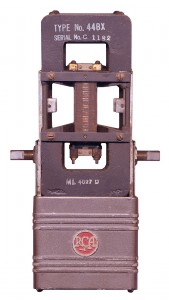
Here at Sweetwater, we believe that there are two types of engineers: those who love ribbon mics and those who haven’t discovered them yet. Ribbon mics weren’t always the obscure, forgotten stepchildren of dynamic microphones that they are today. In fact, when ribbons first hit the scene in the 1920s, they were pretty much the only option available. And while tube mics supplanted ribbon mics well before solid-state technology made condensers cheaper and more available in the 1970s, some designs, such as the RCA 44A (introduced in 1933), are still studio favorites today.
- What Are Ribbon Mics & How Do They Work?
- Active vs. Passive Ribbon Mics
- Ribbon Mic Characteristics
- Applications for Ribbon Mics
- When & Where to Use Ribbons
- Types of Ribbon Mics
What Are Ribbon Mics & How Do They Work?
A ribbon mic is actually a type of dynamic microphone. Instead of a dynamic microphone’s diaphragm that is attached to a moving coil that vibrates within a magnetic field, ribbon mics feature an extremely thin strip of metal (most often aluminum) suspended in a strong magnetic field. The ribbon acts as both the diaphragm and the transducer element itself, providing the same kind of sensitivity and transient response you’d expect from a condenser but with a wholly different character.
Most ribbon microphones are passive devices — meaning that they have no onboard active electronics or preamplification. Because of this, the impedance of the preamp input to which they are connected is critical to the sound produced by the mic. If the impedance is too low, then the frequency response will change, particularly on the bottom end, and the ribbon may become damped, resulting in lowered high-frequency output.
You may think of changing frequency response as a detractor, but it can result in a variety of useful sounds. In fact, it could be seen as a low-frequency EQ option. Here’s an example. Let’s say you have a passive ribbon mic on a source, and because of proximity effect or some other factor, the sound has too much bass. You could reach for an equalizer to tailor the sound, or you could plug the mic into a preamp with variable input impedance and lower the impedance setting. This will reduce the low-end response of the microphone and may result in exactly the sound you’re after. You can always move away from the mic, too, which will minimize the proximity effect’s low-frequency boost.
Active vs. Passive Ribbon Mics
More recently, a new breed of active ribbon microphone has hit the market. But what advantage does that give you? An active ribbon includes onboard electronics that allow the mic to deliver its full potential to a mic preamp regardless of the preamp’s input impedance. The big advantage is that active ribbon mics are more consistent with a range of preamps with different input impedances and typically have stronger output levels than passive ribbons. While passive ribbon microphones deliver fantastic sound quality when paired with the right preamp, active ribbon mics make it easier to accomplish that sound.
Ribbon Mic Characteristics
Ribbon mics have a reputation for being delicate and fragile. This is due, in part, to the extremely thin ribbon material that is suspended in the magnetic gap. Most people aren’t aware of just how thin that ribbon is. On the classic Coles 4038, the ribbon thickness is 0.6 microns; on AEA ribbon mics, it is 1.8 microns; and Royer ribbon mics are either 2.5 or 4 microns thick. To put that in perspective, a typical human hair is about 100 microns (0.001 inches) thick, or more than 50 times as thick as the ribbon in an AEA R84. With this in mind, it’s easy to understand why the extremely delicate aluminum ribbon must be handled with care and protected from blasts of wind or plosives. While most engineers wisely steer away from letting phantom power come anywhere near their ribbon mics, some newer mics, such as the active Royer R-122 MKII, AEA R84A, or Cloud Microphones 44-A, utilize phantom to power their electronics. The Shure KSM313/NE, on the other hand, is virtually indestructible due to its carbon-nanotube Roswellite ribbon.
Ribbon mics also have a reputation for being both quiet and dark, and there is a good reason for this. Classic ribbon mics have a lower output level than contemporary condenser mics, and their greater sensitivity to input impedance can make them sound dark. The right preamp, such as the AEA TRP3, or an in-line amplifying device, like the Cloud Microphones CL-Z Cloudlifter, sE Electronics DM1 Dynamite, Royer dBooster, or Soyuz The Launcher, can work wonders.
As for sonic darkness, the reason ribbon microphones sound darker has to do with the way ribbons react to waveforms of different frequencies. Simply put, lower frequencies affect ribbon mics more than higher frequencies, resulting in a smooth roll-off with decreased output at high frequencies where the waveforms are proportionately shorter. The upside to this is that ribbon mics take EQ beautifully, and all the high frequencies are there, even if slightly diminished, so you can easily bring them out with EQ. Again, that’s not true of all ribbon mics, but it’s generally the case — and if you know to expect it, then you can compensate for it.
Applications for Ribbon Mics
One of the greatest attributes of ribbon microphones is that they’re highly detailed without being oversensitive. That trait allows them to pick up the nuances of close sources while remaining isolated from room noise and off-axis sound that would bleed into most condenser microphones. In terms of practical applications, this quality makes ribbon microphones ideal for miking guitar cabinets or choirs in large spaces where the sound level entering the back of the microphone is far lower than in the front.
The directional pattern of ribbon mics is another fascinating and useful aspect of their design. Unless designed otherwise, all ribbon mics are naturally bidirectional, giving them a figure-8 polar pattern. The reason for this is that sound waves arriving from the side of the thin ribbon element won’t cause it to move at all since the pressure on both sides of the ribbon is identical. The applications for this figure-8 directionality are endless. For instance, ribbon mics were longtime favorites of radio and television talk-show hosts because a single mic could capture both sides of a conversation, while the mic’s sides could be pointed at the audience, the equipment, or the band to block out unwanted sounds.
But, by far, the coolest thing about ribbon mics is their unique nonlinearity, which ribbon mic manufacturers (and evangelists) such as Wes Dooley of AEA describes in this way: “Ribbon mics hear like your ears.” Although this isn’t entirely true, the sonic output of a ribbon mic is remarkably honest and accurate. While, for some sources, you want a microphone to be flattering, ribbon mics are great for when you want your recordings to sound totally natural. Condenser mics and dynamics add a color to your sound you may not like, while a quality ribbon mic will let you record the exact tone you’ve crafted. It’s little wonder so many guitarists love them!
When & Where to Use Ribbons
An Industry Standard for Electric Guitars
Today, countless engineers, producers, and artists rely on ribbon mics for their electric guitar sounds — in the studio and onstage. But prior to the 1998 introduction of Royer’s first ribbon mic, the R-121, ribbons were generally off-limits for use on electric guitar cabs. The new generation of ribbon mics is robust enough that they can be used on any source — and they sound incredible on electric guitar, smoothing out the cutting midrange of overdriven amps while still imparting a low-mid punch that yields powerful tone.
Brass & Woodwinds
For woodwinds such as saxes, clarinets, and oboes, the smooth, natural sound of ribbon mics lets you capture the tonal sweet spot without picking up mechanical noise from the keys and pads while producing a signal that usually needs no further processing. For many engineers, ribbons have been the traditional go-to mics for trumpets and trombones. An AEA R84 on trumpet (about two feet away from the bell) captures the tone of the horn without harshness, while an R-121 or an R-122 MKII straight into a girthy preamp deliver an amazing trombone sound. Perhaps the best thing about using ribbons on brass is that you get all the warmth of the instrument without any stridency when musicians play really loud.
Larger-than-life Strings
If you’re recording a sizable string section in a smaller, ambience-challenged room, then ribbon mics, such as the stereo AEA R88 MkII or mono R84, can provide a more spacious, cinematic sound that belies the size of the acoustical space they’re recording. In fact, a ribbon can be used for a different take on just about any source where you’d normally reach for a condenser or dynamic mic.
Ribbon Mics on Drums
Ribbon mics are great for drum overheads, capturing cymbals without the tizzy hype. An R88 deployed at a reasonable distance on drum overheads delivers a beautiful stereo image of the entire drum kit that can be combined with a kick drum mic for a highly effective, minimalist drum kit recording technique. When used according to Royer’s recommendations, an R-121 works well for miking the bass drum when placed at a 45-degree angle to the drumhead surface.
Ribbon Mics for Stereo Capture
The figure-8 pattern that ribbon mics natively exhibit lends itself to the Blumlein stereo capture technique. Named after renowned British electronics engineer Alan Blumlein, this technique offers excellent stereo separation and control over room ambience. This setup employs two identical figure-8 microphones positioned so that their elements cross at right angles and are as close to one another as possible. The sE Electronics Rupert Neve RNR1 has a svelte form factor and an extended frequency response that make it ideal for high-fidelity Blumlein stereo applications.
Because the figure-8 polar pattern offers complete off-axis (side) rejection, these mics pick up an almost completely isolated (coincident) stereo field. Depending on where you position your Blumlein pair, you can pick up more or less room ambience. Position it very close to the source and far enough away from the rear wall, and you’ll get pure stereo with little ambience. Mid-side (M-S), another popular stereo technique, requires one figure-8 and one cardioid mic, which are combined in post production, but it guarantees phase coherency and mono compatibility.
Types of Ribbon Mics
While classic ribbon microphones, such as the RCA 44B, have been immortalized in the AEA A440 and similar designs, there are many newer ribbon microphones designed for a wide range of applications and purposes. Some, such as the smaller Beyerdynamic M 160, are visually indistinguishable from other kinds of microphones, while ultra-modern designs like the sE Electronics Rupert Neve RNR1 don’t look like traditional ribbon mics at all. At the same time, there are ultra-tough ribbon mics, such as the Shure KSM353/ED or the KSM313/NE we mentioned earlier, which let you take modern ribbons to the live stage and versions of favorites, such as the Royer R-121 Live, that are specially designed for live use.
Sweetwater Has the Ribbon Mic You Want!
When it comes right down to it — no matter the venue or the application — if you want a ribbon mic, then there’s one out there that can do the trick. And Sweetwater is always happy to help you find the right ribbon mic for the job. Call your Sweetwater Sales Engineer at (800) 222-4700.






